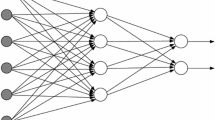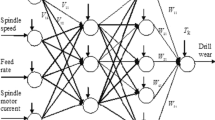Abstract
This study compares the performance of backpropagation neural network (BPNN) and radial basis function network (RBFN) in predicting the flank wear of high speed steel drill bits for drilling holes on mild steel and copper work pieces. The validation of the methodology is carried out following a series of experiments performed over a wide range of cutting conditions in which the effect of various process parameters, such as drill diameter, feed-rate, spindle speed, etc. on drill wear has been considered. Subsequently, the data, divided suitably into training and testing samples, have been used to effectively train both the backpropagation and radial basis function neural networks, and the individual performance of the two networks is then analyzed. It is observed that the performance of the RBFN fails to match that of the BPNN when the network complexity and the amount of data available are the constraining factors. However, when a simpler training procedure and reduced computational times are required, then RBFN is the preferred choice.









Similar content being viewed by others
References
Thangaraj A, Wright PK (1988) Computer-assisted prediction of drill failure using in-process measurements of thrust force. J Eng Ind, Trans ASME 110:192–200
Noori-Khajavi A, Komanduri R (1995) Frequency and time domain analyses of sensor signal in drilling-II, investigation on some problems associated with sensor signal. Int J Mach Tools Manuf 35:795–815
Lin SC, Ting CJ (1995) Tool wear monitoring in drilling using force signals. Int J Mach Tools Manuf 180:53–60
Lin SC, Ting CJ (1996) Drill wear monitoring using neural network. Int J Mach Tools Manuf 36:465–475
Dimla DE Jr, Lister PM, Leighton NJ (1997) Neural network solutions to the tool condition monitoring problem in metal cutting: a critical review of methods. Int J Mach Tools Manuf 37(9):1219–1241
Lee BY, Liu HS, Tarng YS (1998) Modeling and optimization of drilling process. J Mater Process Technol 74:149–157
Elhachimi M, Torbaty S, Joyot P (1999) Mechanical modeling of high speed drilling in predicting torque and thrust. Int J Mach Tools Manuf 39:553–568
Liu HS, Lee BY, Tarng YS (2000) In process prediction of corner wear in drilling operations. J Mater Process Technol 101:152–158
Choudhury SK, Raju G (2000) Investigation into crater wear in drilling. Int J Mach Tools Manuf 40:887–898
Ertunc HM, Loparo KA, Ocak H (2001) Tool wear condition monitoring in drilling operations using hidden markov models (HMMs). Int J Mach Tools Manuf 41:1363–1384
Ertunc HM, Loparo KA (2001) A decision fusion algorithm for tool wear condition monitoring in drilling. Int J Mach Tools Manuf 41:1347–1362
Davim JP, Antonio CAC (2001) Optimal drilling of particulate metal matrix composites based on experimental and numerical procedures. Int J Mach Tools Manuf 41:21–31
Tsao CC (2002) Prediction of flank wear of different coated drills for JIS SUS 304 stainless steel using neural network. J Mater Process Technol 123:354–360
Brophy B, Kelly K, Byrne G (2002) AI-based condition monitoring of the drilling process. J Mater Process Technol 124:305–310
Kim HY, Ahnn JH, Kim SH, Takata S (2002) Real-time drill wear estimation based on spindle motor power. J Mater Process Technol 124:267–273
Jantunen E (2002) A summary of methods applied to tool condition monitoring in drilling. Int J Mach Tools Manuf 42:997–1010
Hocheng H, Tsao CC (2003) Comprehensive analysis of delamination in drilling of composite materials with various drill bits. J Mater Process Technol 140:335–339
Mahfouz IA (2003) Drilling wear detection and classification using vibration signals and artificial neural network. Int J Mach Tools Manuf 43:707–720
Nouari M, List G, Girot F, Coupard D (2003) Experimental analysis and optimization of tool wear in dry machining of aluminium alloys. Wear 255:1359–1368
Wong SV, Hamouda AMS (2003) Machinability data representation with artificial neural network. J Mater Process Technol 138:538–544
Sonar DK, Dixit US, Ojha DK (2005) The application of a radial basis function neural network for predicting the surface roughness in a turning process. Int J Adv Manuf Technol 36:400–451
Singh AK, Panda SS, Pal SK, Chakraborty D (2005) Predicting drill wear using an artificial neural network. Int J Adv Manuf Technol DOI: 10.1007/s00170-004-2376-0 (in press)
Haykin S (2003) Neural networks: a comprehensive foundation, 2nd edn. Pearson Education
Moody J, Darken CJ (1989) Fast learning in networks of locally tuned processing units. Neural Comput 1(2):281–294
Author information
Authors and Affiliations
Corresponding author
Rights and permissions
About this article
Cite this article
Garg, S., Pal, S.K. & Chakraborty, D. Evaluation of the performance of backpropagation and radial basis function neural networks in predicting the drill flank wear. Neural Comput & Applic 16, 407–417 (2007). https://doi.org/10.1007/s00521-006-0065-7
Received:
Accepted:
Published:
Issue Date:
DOI: https://doi.org/10.1007/s00521-006-0065-7




